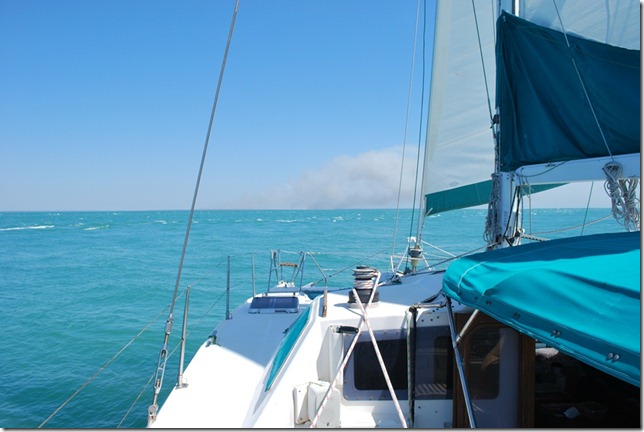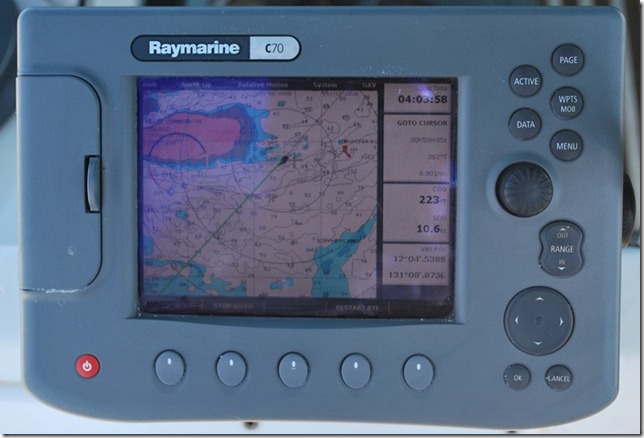Well, we’re finally anchored in Darwin, but not without an interesting final day on passage. After talking to S/V Imagine on the SSB and realizing this might be our last chance to see them before they leave for Indonesia (and finally getting tired of creeping along at 2-2.5 knots) we finally turned on an engine. We’d only accumulated about 4 engine hours since leaving Cairns, so why not? Oh yeah, there were no more chips in our snack compartment either, so there was a building sense of urgency.
The last part of the passage into Darwin passes through the Van Diemen Gulf, a large, bay about 90 nm wide with openings at the northeast and west and the rest of its circumference formed by the Australian mainland in the south and east and Melville Island in the north. The gulf is big and the mouths are relatively narrow and shallow, which means that when the large tides in this area ebb and flow, there’s quite a bit of current. Life is a lot better when you’re running with the current instead of trying to fight it, so the ideal way to finish this passage is to let the incoming tide suck you into the gulf at the Dundas Strait, sail as fast as you can across to the west side and then let the outgoing tide spit you out through the Clarence Strait. If your timing is really good, you’ll get out of the gulf just in time to let the next incoming tide push you down to Darwin.
I hadn’t planned any of this when I got up for my 3 am watch, just as we were nearing the Dundas Strait. After six days at sea just taking what the winds provided, I wasn’t even sure what the state of the tide was going to be. I soon found out, though. We’d been warned that Cap Don could get pretty rough if you didn’t catch an incoming tide, but as we motorsailed by it at about 5 am and entered the Van Diemen Gulf, the water was incredibly calm and the boat speed kept climbing. 5 knots is a good average speed for us, 6 knots is great, and averaging 7 knots for a day is almost unheard of. As the tide sucked us in, I watched the GPS speed climb above 8 knots and then above 9. As it hovered at 9.9 I wondered if we’d make 10 and then it hit 10 and kept climbing. We topped out at 11 knots, and stayed above 10 knots for well over a quarter of an hour. The whole time, the boat was almost as still as if it was at anchor.
Australia only releases a few days of tide information at a time on the internet for free (as well as the whole year’s tides for a few locations) and if you want the rest you have to buy an expensive tide table book. Luckily I’d been given some tide software by another cruiser that seemed to be reasonably accurate. After obviously getting lucky on our way in, I was ready for more of the same and pulled up tide programs and charts on the laptop to try to plan the day. As it turned out, we were able to time things almost perfectly and with the help of the second engine when the wind was light, we were able to make it all the way to Darwin before sunset while only fighting the current for a few hours of the trip. From passing Cape Don until we anchored in Darwin, we covered 93.6 nautical miles in 11-12 hours for an average speed of about 8 knots (around 10 mph). It really doesn’t take much to get you excited after a week at sea.
 The line of whitecaps ahead is the edge of a strong tidal rip. The smoke is from a large brush-burning fire on the mainland.
The line of whitecaps ahead is the edge of a strong tidal rip. The smoke is from a large brush-burning fire on the mainland.
 10.6 knots (This is the part where you say WOW! THAT’S REALLY FLYING!)
10.6 knots (This is the part where you say WOW! THAT’S REALLY FLYING!)
The only bad part of the day was hitting a rough patch of water in the gulf where the tide was running against a strong wind that we were sailing into. We hadn’t had any rough seas for so long that we once again got caught with a hatch open and managed to soak our berth pretty well, including some electronics that we’re hoping will recover. Lauren went right to work on it though, and after several hours of work she had it pretty much put back together by time we made it to Darwin. She really is amazing.
S/V Imagine was still here when we arrived and after a quick dinner we had a great evening with them, getting their tips on Darwin and talking over experiences we’d had. It was so nice to see them that I caught a second wind and even though I had gotten up at 3 am and they had to leave with the tide early in the morning, we didn’t get to bed until midnight. Needless to say I had a great night’s sleep.

